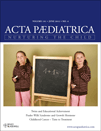Fractures in a tertiary Neonatal Intensive Care Unit in Wales
Abstract
Aim: To explore associations with fractures reported in a tertiary neonatal intensive care unit (NICU).
Method: Babies admitted to NICU from 1998 to 2007 in Cardiff, UK, with fractures during admission were identified. Clinical information was extracted from inpatient records. Results were reported as median (ranges).
Results: Seventy-one fractures were recorded in 27 (boys = 16) infants with a gestational age of 28 (23.6–40.4) weeks and birthweight of 920 g (485–4875). Fractures were recognized at 57 (1–128) days of age. Neonates with fractures without clear aetiologies (n = 17) were more preterm (p < 0.001), were born lighter (p < 0.001), required multiple medical interventions, were more commonly osteopenic (p < 0.001), had fractures detected later (p < 0.001) and had more posterior rib fractures (p = 0.009). Rib fractures were detected later than other sites (p = 0.002). Associations with rib fractures included osteopenia (p = 0.04), longer oxygen therapy (p = 0.018), length on total parental nutrition (p = 0.03), later achievement of full enteral feeds (p = 0.038), sepsis (p = 0.038) and surgical procedures (p = 0.004). Posterior rib fractures were more common in babies born more preterm (25.1 vs. 29.4 weeks, p = 0.003) and requiring diuretics (p = 0.027).
Conclusion: Fractures in premature infants are associated with a variety of predisposing factors. Clinicians evaluating the cause of rib and multiple fractures in preterm neonates shortly after discharge need to take these factors into consideration.




